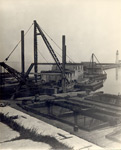Dry Dock in Oswego
- Publication
- Syracuse Journal (Syracuse, NY), April 18, 1867
- Full Text
Dry Dock in Oswego. - Mr.
Carrington , President of theOswego and Syracuse Railroad Company , is now constructing a magnificent dry dock inOswego . The excavation is entirely out of solid rock, and of course the blasting is on a magnificent scale. The contract for blasting has been taken by two gentlemen of our city, and they are using nitro glycerine in the work.Their contract requires the excavation of 12,000 or 14,000 yards, and they are now progressing finely with the work. We witnessed one or two blasts yesterday which demonstrated completely the tremendous efficiency of nitro glycerine. The face of the work was about five feet perpendicular and fifty feet across from side to side. The top was quite level and the drill holes were placed six feet from the edge of the ledge and about eight or ten feet apart.
They were sunk to a depth of about five feet and, charged with glycerine, exploded simultaneously. Only four drills were charged, but the result was the detachment and complete breaking up of the entire ledge back ten feet at least from the face to a depth of five feet, besides the cracking of the rock into large fissures, at least six feet still further back. The mass of rock blasted out by this discharge could not be less than one hundred cubic yards and was effected with about two pounds of nitro glycerine.
Three or four blasts can be made daily, and such moving of the rocks was never before seen in Oswego. Immense works of a similar kind are in contemplation, in extending the channel of the river, and if no accident occurs in the use of blasting oil, a large demand for it will be created in Oswego alone. The blasting yesterday was witnessed by a large number of citizens of Oswego, among whom were representatives of the press, who, after the first discharge of an oil blast, which filled the air with fragments of rocks, exemplified their full belief in the oft quoted phrase " 'Tis distance lends enchantment to the view."
In the case in which we witnessed its operation yesterday, the holes in the rock were drilled to a depth of five to ten feet, and about seven feet apart, for a distance of fifty feet across the rock. The blasts broke up the rock for a distance of sixteen feet back from the drill holes, and the execution done by this powerful, and yet harmless looking agent, was perfectly wonderful.
The rock was torn in all directions, and wherever there were natural seams it was broken in line of their direction. It seems to us that, in view of its cheapness, comparative safety, and wonderful power, it must come into general use for all purposes of heavy blasting, and must ultimately supersede the manifestly less effective agency of powder.
- Media Type
- Text
- Newspaper
- Item Type
- Clippings
- Date of Original
- April 18, 1867
- Subject(s)
- Local identifier
- GLN.3331
- Language of Item
- English
- Geographic Coverage
-
-
New York, United States
Latitude: 43.45535 Longitude: -76.5105
-
- Donor
- Richard Palmer
- Copyright Statement
- Public domain: Copyright has expired according to the applicable Canadian or American laws. No restrictions on use.
- Contact
- Maritime History of the Great LakesEmail:walter@maritimehistoryofthegreatlakes.ca
Website:


